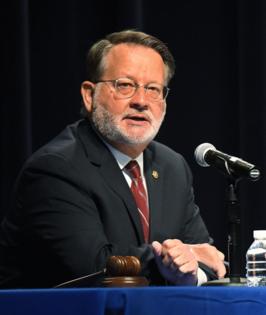Lawmakers look to alleviate Senate confirmation pain
Published in News & Features
WASHINGTON — The confirmation of presidential appointees has increasingly become a drag on the Senate, eating up more of the chamber’s schedule and pushing legislation to the back burner. A bipartisan pair of senators say they want to bring transparency to the process.
Sens. Gary Peters, chairman of the Homeland Security and Governmental Affairs Committee, and James Lankford, an Oklahoma Republican who sits on the committee, last week introduced a measure that would create a dashboard to track the status of roughly 1,300 Senate-confirmed positions, giving Congress and the public an up-to-date view.
“The Senate has a constitutional duty to provide advice and consent on presidential appointees, but unfortunately the cumbersome confirmation process and growing number of nominees is cutting into the amount of time Congress can devote to moving legislation that benefits the American people,” Peters, a Michigan Democrat, said in a statement.
His committee is set to mark up the bill Wednesday. Senate Rules and Administration Chairwoman Amy Klobuchar, D-Minn., is also a co-sponsor.
The proposal comes as the Senate continues to struggle through a backlog of nominations in a timely manner, frustrating lawmakers, executive branch agencies and good-governance types. With few days left on the legislative calendar this Congress, its fate is unclear, though there is some consensus that the current process isn’t working.
The pace of Senate confirmations has turned the chamber into a “full-time employment agency,” Klobuchar said at a hearing in July. “It’s just not serving our democracy well,” Oregon Democratic Sen. Jeff Merkley said at the same hearing.
The new proposal wouldn’t necessarily speed things up, according to Michael Thorning, director of structural democracy at the Bipartisan Policy Center. But it’s a step in the right direction, he said.
“What I think this bill will do is provide senators and staff better awareness and insight into the current status of Senate confirmations and positions in the executive branch,” Thorning said. “In terms of resolving the overall slowness and time-consuming nature of Senate confirmations, this may help to catalyze change, but in and of itself probably will not.”
Part of the problem is the steady increase of positions requiring Senate confirmation, according to Jenny Mattingley, vice president of government affairs at the Partnership for Public Service.
The more than 1,300 political appointees the Senate must consider and vote on increased by over 70 percent between 1960 and 2020, Mattingley testified before the Rules Committee in July.
As the number of positions has increased, so too has the time it takes to confirm candidates. During President Ronald Reagan’s first term, it took 49 days on average to confirm nominees, according to Partnership for Public Service data. The average confirmation time peaked at 204 days during Barack Obama’s second term, then quickened slightly to an average of 160.5 days for Donald Trump. Through April 2024 of Joe Biden’s term, it had taken 182 days on average. (All those averages exclude judicial, military, U.S. marshal and U.S. attorney nominees.)
Votes on nominees have also begun to take up a large share of floor time.
From the administration of George H.W. Bush through Obama’s second term, votes on legislation made up the vast majority of all Senate votes, according to a Partnership for Public Service analysis. But just 35 percent of all Senate votes during Trump’s administration were on legislation. That number ticked up to just 40 percent under Biden as of May, with votes on executive and judicial nominations dominating.
“I think when you see the data, it paints a picture where everything is trending in the wrong direction here in terms of time and how many political appointees there are, and how we’re handling this,” Mattingley said.
While not a silver bullet, creating a database is one of several potential fixes Mattingley and other witnesses floated at the July hearing.
The legislation would require the Government Accountability Office to create a public dashboard that would list which Senate-confirmed executive branch positions have been filled, the names of people serving in them, and “the status, within the Senate advice and consent process, of individuals nominated,” according to the bill text.
It would build on a law enacted in 2022 that requires the Office of Personnel Management to post certain information online about appointees, such as names, agencies and pay grades. That website replaces a quadrennial publication known as the Plum Book and is meant to be more accurate and up-to-date. But the data on the website, which was current as of March 4, does not provide a real-time view of how nominees are moving through the process.
The dashboard suggested by Peters and Lankford would match some of the information from the OPM-managed site, while also tracking data and trends about vacancies and acting officials. The proposal calls for “graphics and charts” and frequent updates “on not less than a weekly basis.” By instituting new reporting requirements for committees and the secretary of the Senate, the proposal aims to track any new Senate-confirmed positions created by legislation.
A spokesperson for the Partnership for Public Service said in an emailed statement that the committee reporting requirement, in particular, is “an increase in transparency that is much needed.”
Such a database could aid an effort to better understand, and ultimately eliminate, some of the positions that currently require Senate approval, which Thorning said is critical to reducing the total time the chamber spends on nominees.
“There are a number of positions that I think most Americans would be shocked to find require Senate confirmation,” said Thorning. “There’s a real need for a top-to-bottom review of what’s included and what should not be included.”
The Senate’s last large-scale attempt to address the problem came in 2011. That effort produced the privileged calendar — which is meant to expedite the process by allowing noncontroversial nominees to bypass committee — and also trimmed the list of Senate-confirmed positions.
But the privileged calendar did not exactly produce a fast track for nominations, according to the Partnership for Public Service. And Mattingley suspects the total number of Senate-confirmed positions has ticked up in the last decade — though without a comprehensive database, she said she can’t be certain of exact numbers.
“There isn’t one consistent place to go see what positions [there] are. You have to dig through reports and legislation. So that’s one of the things we think would be helpful to have,” Mattingley said.
In addition to the database, other proposals to fix the confirmation process have been floated this Congress.
Klobuchar, for one, introduced a resolution last year that would allow the bundling of up to 10 lower-level nominees advanced out of the same committee to be considered together on the floor for a vote.
Already many nominations are considered “en bloc,” allowing hundreds to be considered at one time. The “en bloc” approach expedites things, but it requires unanimous consent, and individual senators wield the power to hold up confirmation. Lawmakers on both sides of the aisle have used the tool to gum up the works and score partisan points.
Klobuchar’s proposal would change the rules to allow a majority vote for confirmation without requiring unanimous consent. But the Minnesota Democrat’s bill has so far not seen any action, and time for any proposal is dwindling, though lawmakers at this summer’s Rules Committee hearing expressed interest in addressing the issue quickly.
“The challenge is a reflection of almost tribal-level warfare between the parties. The minority … has an incentive to slow things down, make it difficult, extract promises — regardless of who’s there,” Merkley said at the July hearing. “Which is why right now is the right time for us to have this conversation. We have no idea who will be in the Oval Office. We have no idea who will be in the majority of the Senate.”
Thorning said that because creating an online tracker wouldn’t benefit one party over another, the bill set to be marked up Wednesday could have broad appeal. But political incentive for larger changes could wither once a new new president is elected.
“Is there a commitment from leadership to bring it to the floor when they have pretty limited time left before the election?” Thorning said in August when asked about any potential action this Congress. “And then after that, does the air get sucked out of the room when one side or the other knows that their party controls the White House?”
©2024 CQ-Roll Call, Inc., All Rights Reserved. Visit cqrollcall.com. Distributed by Tribune Content Agency, LLC.







Comments